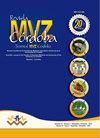库库塔环境中新生隐球菌和gattii隐球菌的恢复及其与临床分离株的相关性
IF 0.3
4区 农林科学
Q4 AGRICULTURE, DAIRY & ANIMAL SCIENCE
引用次数: 0
摘要
西班牙语摘要目标。从库库塔市的环境和临床样本中分离、鉴定和分子表征人类致病性隐球菌的分离。材料和方法。在库库塔的10个公共区域收集了来自10个不同物种的446棵树的1300个样本。同时,获得了新型隐球菌的临床分离株(2016年6月至2017年6月)。利用PCR-指纹图谱和RFLP-URA5技术,在琼脂中培养了无根结缕草种子,随后进行了生化鉴定和遗传鉴定。结果。环境患病率为4.3%(19名阳性个体)的新冠肺炎和0.2%(1名阳性个体),共有21个分离株和20棵阳性树木。桑坦德公园记录了47.6%的全球流行率(10/21孤立),其次是维多利亚公园,为23.8%(5/21孤立),对应于新冠肺炎。在梅赛德斯阿布雷戈公园的一个榕树个体中获得了一株C.gattii的分离株。基因分型分析显示,85.7%的环境分离株和100%的临床分离株中存在新冠肺炎,其次是9.5%的环境分离株和4.8%的环境分离株中存在新冠肺炎。结论。对先前报告的真菌环境生态位的纵向取样揭示了其存在,并建议对环境和患者进行持续监测,特别是在城市的流行地区。目标英语。从库库塔市的环境和临床样本中分离、鉴定和分子表征人类的致病性隐球菌分离株。材料和方法。共从库库塔10个公共地区10种不同物种的446棵树中采集了1300个样本。同时,获得了新冠隐球菌的临床分离株(2016年6月至2017年6月)。这些样本在吉佐蒂亚无菌种子培养基中培养,然后通过PCR指纹图谱和URA5基因的RFLP进行生化鉴定和表征。结果。C、 新形成者的环境患病率为4.3%(19名阳性个体),C.Gattii的环境患病率为0.2%(1名阳性个体);这总共产生了20株隐球菌阳性树和21株分离株(两株来自同一个体)。桑坦德公园登记了47.6%的全球流行率(10/21个隔离区),其次是维多利亚公园,为23.8%(5/21个隔离区),对应于C.新形式。一棵C.Gattii Isolate是从梅赛德斯阿布雷戈公园的一棵榕树中采集的。基因型分析显示,85.7%的环境隔离物和100%的临床隔离物中存在新冠肺炎。VNII和VGII分子类型分别占环境隔离物的9.5%和4.8%。结论。对先前报告的真菌环境巢穴的纵向抽样显示了其存在,并建议在环境和患者中,特别是在城市的地方性地区,都需要进行永久监测。本文章由计算机程序翻译,如有差异,请以英文原文为准。
Recovery of environmental Cryptococcus neoformans and Cryptococcus gattii in Cúcuta and association with clinical isolates
espanolRESUMEN Objetivo. Aislar, identificar y caracterizar molecularmente aislamientos de Cryptococcus patogenos para humanos a partir de muestras ambientales y clinicas de la ciudad de Cucuta. Materiales y metodos. Se recolectaron 1300 muestras de 446 arboles de 10 especies diferentes, en 10 zonas publicas de Cucuta. Concomitantemente, se obtuvieron aislados clinicos de Cryptococcus neoformans (junio de 2016-junio de 2017). Se realizo cultivo en agar semillas de Guizottia abysinica, posterior identificacion bioquimica y caracterizacion genetica mediante PCR-huella Digital y RFLP-URA5. Resultados. Se determino prevalencia ambiental para C. neoformans de 4.3% (19 individuos positivos) y C. gattii de 0.2% (1 individuo positivo), para un total de 21 aislados y 20 arboles positivos. El parque Santander registro el 47.6% de la prevalencia global (10/21 aislados), seguido del parque La Victoria con 23.8% (5/21 aislados), correspondientes a C. neoformans. Se obtuvo un aislado de C. gattii en un individuo Ficus benjamina del parque Mercedes Abrego. El analisis genotipico revelo presencia de C. neoformans var. grubii VNI en el 85.7% de los aislados ambientales, asi como en el 100% de los clinicos, seguido de VNII y VGII en 9.5% y 4.8% de los aislados ambientales, respectivamente. Conclusiones. El muestreo longitudinal de los nichos ambientales previamente reportados del hongo revela su presencia y sugiere que se requiere una vigilancia permanente tanto en el medio ambiente como en los pacientes, especialmente en las zonas endemicas de la ciudad. EnglishABSTRACT Objective. Isolate, identify and molecularly characterize pathogenic Cryptococcus isolates for humans from environmental and clinical samples from the city of Cucuta. Materials and methods. A total of 1300 samples were collected from 446 trees of 10 different species in 10 public areas of Cucuta. Concomitantly, clinical isolates of Cryptococcus neoformans were obtained (June 2016-June 2017). The samples were cultivated in Guizottia abysinica seed medium and were then biochemically identified and characterized by PCR fingerpinting and RFLP of the URA5 gene. Results. C. neoformans displayed an environmental prevalence of 4.3% (19 positive individuals), and that of C. gattii was 0.2% (1 positive individual); this yielded a total of 20 Cryptococcus-positive trees and 21 isolates (two from the same individual). Santander Park registered 47.6% of the global prevalence (10/21 isolates), followed by La Victoria Park with 23.8% (5/21 isolates), corresponding to C. neoformans. One C. gattii isolate was collected from a Ficus benjamina tree located in Mercedes Abrego Park. Genotypic analysis revealed the presence of C. neoformans var. grubii VNI in 85.7% of environmental isolates as well as 100% of clinical isolates. VNII and VGII molecular types represented 9.5% and 4.8% of the environmental isolates, respectively. Conclusions. The longitudinal sampling of previously reported environmental niches of the fungus reveals its presence and suggests that permanent monitoring is required both in the environment and in patients, especially in endemic areas of the city.
求助全文
通过发布文献求助,成功后即可免费获取论文全文。
去求助
来源期刊

Revista Mvz Cordoba
农林科学-奶制品与动物科学
CiteScore
0.70
自引率
0.00%
发文量
41
审稿时长
6-12 weeks
期刊介绍:
The Journal MVZ Córdoba is an open access international scientific journal financed and edited by the University of Córdoba (Colombia). The journal publishes quarterly, continuously in PDF, XML, Epub, original articles, literature reviews, brief communications and clinical cases, peer-reviewed (double-blind) in Spanish and English, which are related to the agricultural and veterinary sciences. The journal is directed to natural and legal persons of veterinary medicine, animal husbandry, public health, epidemiology, aquaculture, biology, basic biomedical sciences and biotechnology and constitutes a space for academic and scientific discussion around the work of professionals in Veterinary Medicine and Zootechnics. Four-monthly publication.
"The Journal MVZ Córdoba supports the policies for registration of clinical trials of the World Health Organization (WHO) and the International Committee of Medical Journal Editors (ICMJE), since it recognizes the importance of these initiatives for international registration and dissemination. of information about clinical studies, in open access. As a result, since 2007, the journal MVZ Córdoba only publishes clinical research articles that have received an identification number in one of the Clinical Trial Registries validated by the criteria established by WHO and ICMJE, whose addresses are available in the ICMJE website. The identification number is recorded at the end of the summary. "
 求助内容:
求助内容: 应助结果提醒方式:
应助结果提醒方式:


